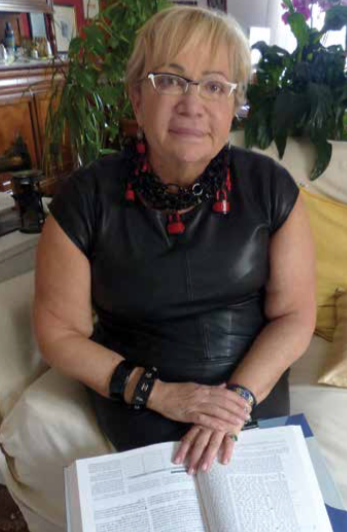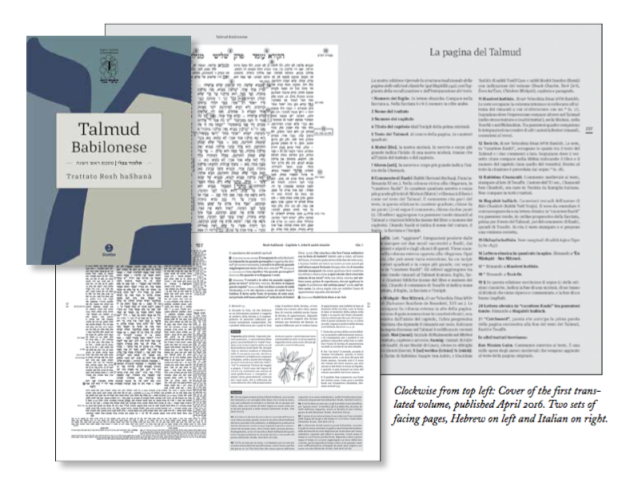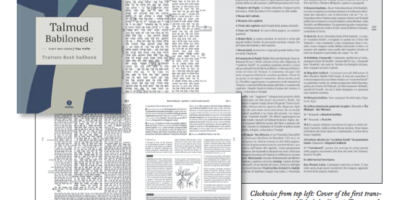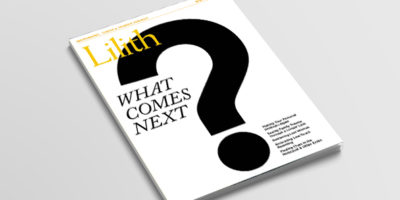
Clelia Piperno
The female force behind the world’s first Talmud translation to use software.
 Make my nomination for Lilith Woman of the Year Clelia Piperno.
Make my nomination for Lilith Woman of the Year Clelia Piperno.
This Italian force of nature got the Italian government to allocate 5 million euros for the first translation of the Talmud into Italian and the world’s first-ever Talmud translation using specially developed, made-in-Italy software.
Piperno, 62, names her three major interests as women, new technology, and Judaism. Six years ago, she convinced the chief rabbi of Rome, Riccardo Di Segni, to chair the project. Piperno is project director and heads its board of directors
With support from various government entities and Rabbi Di Segni, she gained the backing of Berlusconi’s minister of education, who turned the idea into a special project of the National Research Council. Once Piperno brought together a broad-based consortium, including the government, the National Research Council, the Union of Italian Jewish Communities and the Italian Rabbinical College, funding began.
A chunk of the Talmud Project budget has gone to Italy’s National Research Council’s Institute of Computational Linguistics to develop the “Traduco” (“I translate”) software. The undertaking, which Piperno describes as “a research project, not a translation project,” has been in the works since 2010, with translation starting in 2012. After startup glitches and hurdles, the gamma version of Traduco, able to suggest both translation and page layout, launched in 2014.
In the beginning, the team of translators—all connected through the Traduco online server —started working their way through the Talmud word by word, translating the Adin Steinsaltz modern Hebrew edition into Italian. Piperno explains. “Traduco suggests words, but humans do the translation. As the project develops, there are more and more strings (computerized units of translated words and phrases) and the translation goes faster and faster. Everyone is working in parallel or it would take much more time.”
The hefty 416-page Rosh HaShana Tractate, the first volume in Italian, made its debut in Rome this past April. An additional eight volumes are currently in the works and government funding has doubled to 10 million euros.
In June, Piperno, went to Jerusalem, part of a stellar contingent, to present the project to the Israeli minister of education. The delegation included the Italian minister of education, Rabbi Di Segni and the past president of the Union of Italian Jewish Communities.
Piperno has her eye on New York for 2017. The purpose: to present the results of the research as the only web-oriented translation project, totally government financed, with translators working from three continents, all on the same browser.
As a measure of the national importance of the project, the first translated volume was presented at Italy’s national academy of science and literature in Rome, the venerated Accademia dei Lincei, into which Galileo was inducted 500 years ago. The academy is also the site of the first Talmud Network class in December 2016, for a Rosh HaShana Tractate study session bringing together the Talmud Project rabbis, informatics professionals and other staff.
In a country whose Jews number only some 28,000 in a population of slightly less than 60 million, Piperno forcefully rejects the idea that the government’s multi-million euros might be considered reparation. “No one can give back any- thing to repair what Mussolini’s racist laws were able to destroy….We are getting a proper investment on what has been proposed: an innovative idea that will make the Talmud accessible to Italian citizens, hundreds of years after the burning of the Talmud by papal order and 78 years after the racial laws.”
Her own family traces its Italian roots back to the 1st Century C.E. in the reign of the Emperor Titus. Two family members who survived Auschwitz-Birkenau died recently.
Today, Jews and non-Jews work together in a project of Jewish studies financed by the state. Piperno says, “It is not a form of reparation, but a cultural challenge built by the daughters and sons of the persons who were expelled from humanity in all its forms.”
Discussing the project in her apartment in Rome shortly after the first volume’s debut, Piperno explains how the idea came to her. She’d been convalescing from risky surgery for a bone problem that had crippled her. She had already survived a medically induced coma for pulmonary problems and breast cancer. She says: “Without risk, there is no life.” Today, she doesn’t walk. She surges—in heels and a body-hugging short black leather dress, accessorized with a black- and-red necklace featuring locks hanging from giant chains (perhaps alluding to the Talmud challenge).
Married and divorced, she has raised two sons —Michael Dollinar, the Talmud Project’s web master, and Sigmund Dollinar, cartoonist. She has spent several decades contributing to research on women’s access to institutional decision- making. Last year, she founded, and currently chairs, Italy’s Society on Gender and Medicine, a new branch of medical research on gender differences within the same illness.
During her convalescence, in 2009— reading, listening to music, using the Internet—her search for the translation of a psalm led her to the Steinsaltz modern Hebrew translation of the Talmud. Eventually, the idea of an Italian translation came to her, along with her determination to find the money to fund it.
She brings to the project academic credentials as a law professor at the University of Teramo, a track record managing large sums of public money (she co-chaired the government committee financing reconstruction in the Balkans after the war), and years of advising on public-private cooperation in development projects.
About getting everyone on board for the Talmud Project, Piperno says, “You can’t believe how easy it was.” When asked “Why the Jews and not the Muslims, not the Catholics?” received millions in government funding, she says bluntly, “No one else had the idea.”
With constant fine tuning, Traduco is assisting the international team of translators, scholars and computer experts in overcoming the language barriers of the Talmud’s patchwork of commentaries on everything from religious and legal issues to science and daily living.. The distinctive Talmud pages encompass a central text completed some 1,500 years ago with 11th century commentaries by Rashi to one side and subsequent medieval commentaries tucked in.
The task is sufficiently complex that few translations exist, with the major ones having been in English and German. Rabbi Adin Steinsaltz’s modern Hebrew translation, completed in 2010, took 45 years with only a few assistants. The complete Italian translation, some 30 volumes totaling thousands of pages, should be completed in eight more years. Piperno expects an online version in five years.
An example of Piperno’s management skills: translators are paid on completion of specific assignments. “There’s a contract. You work. You’re paid. You don’t work, you’re not paid. This is unusual in Italy. Normally you have a contract, you’re paid. No one’s checking the result.”
Piperno’s Jewish background includes chairing the Italian Jewish Youth Union, writing for Italy’s Jewish newspaper, and more time spent in Israel than she can quantify, she says. She describes her early Jewish learning as “not much,” and her Jewish family life as “a lot.” As an adult, she has studied the Talmud on her own and frequently sits in on Talmud scholars’ lectures, classes and discussions. She says, “This is the unique privilege that comes with directing a project like this.”
As to the rarity of a woman heading a major, mostly male undertaking in a country proud of its machismo traditions, unlocking key texts of a deeply paternalistic religion, Piperno says, “It’s their problem, not mine.” The chief rabbi doesn’t have a problem. He didn’t realize it was a problem.” She adds, “The ‘rav’ doesn’t need to control me. He just trusts me. It’s a big responsibility.”
More information on the Talmud Project at www.talmud.it/il-talmud.html.
Amy Stone is a founding mother of Lilith, now a contributing editor and an ongoing Lilith blogger.



